DISCOVER BEAUTIFUL BESANCON – 2,000 YEARS OF HISTORY
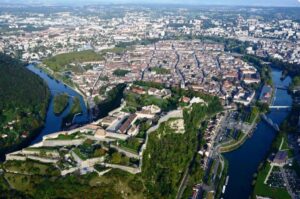
On a recent visit to France, we planned on visiting the beautiful Alsace Lorraine region on the country’s eastern border with Switzerland, where we had not been for a number of years. For a stopover, we decided to stay in Besançon, capital of the region of Franche Comté, a town that we had only briefly passed through years ago. We did some preliminary research into the attractions of Besançon and realised we had missed out on a very interesting, lovely town, whose history dates back to the 1st century BCE. It also has one of the country’s most spectacular citadels, designated as a UNESCO World Heritage Site—surely a good enough reason to visit this fascinating town.
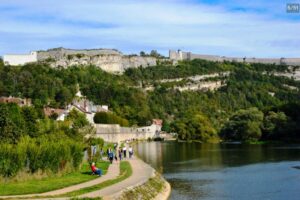
There are many facets to a visit to Besançon. It offers a unique experience whereby visitors can immerse themselves in its history, stroll its delightful streets, explore a particularly outstanding monument, and one of France’s finest Fine Arts museums. It also has many natural attractions such as its position on a curl, or loop, on the Doubs River, a tributary of the River Saône. The town is dubbed La Boucle (the buckle) as it’s surrounded by the river on three sides—known as an oxbow loop—with pathways, forests and marshlands making up its great diversity of landscape. It’s easy to see why Besançon has become known as the greenest city in France, and often called the French Switzerland.
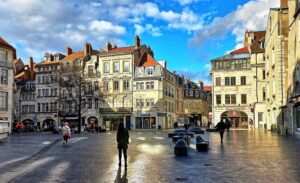
Besançon is many different things: it’s a winegrowing town, the birthplace of great men, including Victor Hugo, a place of invention and innovation, and biodiversity, becoming a centre for innovative companies in the fields of microtechnology, micromechanics and biomedical engineering. It’s also famous for its watchmaking industry, with watchmakers, originally from Switzerland, establishing themselves in the heart of the town so that it became one of the town’s main activities. A watchmaking school and an observatory at the end of the 19th century ensured the future development of industrial activities. Besançon became the capital of French watchmaking, such that its know-how was inscribed on UNESCO’s Intangible Heritage List in December 2020.
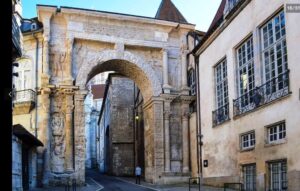
During the Bronze Age, c.1500 BCE, tribes of Gauls settled in the area, so that the city was already important during the Gallo-Roman era. It was first recorded in 58 BCE as Vesontio in Book 1 of Julius Caesar’s ‘Gallic Wars’, and became the capital of the Sequani. Its name underwent several transformations to become Besançon in 1243.
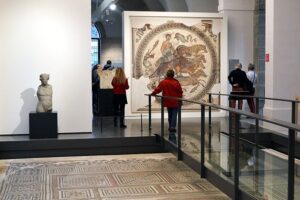
From 1st century BCE through to the modern era, the town had significant military importance because the Alps rise sharply to its south, presenting a natural barrier. It’s understandable that its geographic location and specific history turned it into a military stronghold, a garrison city, a political centre and a religious capital. Most of the conflicts involving Besançon were due to commercial reasons. Each of the local tribes claimed the tolls on trade along the river. One tribe, the Sequani, controlled access to the Rhine and had built an oppidum (a fortified town) at Vesontio to protect their interests. This tribe defeated and massacred a rival tribe, the Haedui, with the help of two Germanic tribes led by a Germanic king, Ariovistus. Such battles became quite common until the arrival of the Romans under Julius Caesar, who used such conflicts between Gallic tribes to his advantage when he launched his conquest of Gaul. He described this naturally defensive site as the “jewel in my crown.”
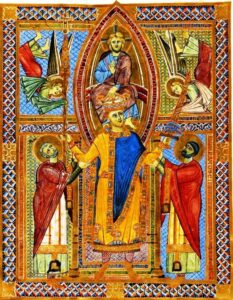
In 843, the Treaty of Verdun divided up Charlemagne’s empire. Besançon became part of Lotharingia, under the Duke of Burgundy. As part of the Holy Roman Empire since 1034, the city became an archbishopric, and was designated an autonomous city-state under the Holy Roman Emperor in 1184. The Archbishops were elevated to Princes of the Holy Roman Empire in 1288, and this close connection to the Empire is reflected in the city’s coat of arms. The Emperor finally granted Besançon its independence in 1290 after a century of fighting against the power of the archbishops.
During the Renaissance years, Besançon passed into the hands of various Holy Roman Emperors, then the whole region came under the control of the Kings of Spain, whereupon it lost its status as a free city. Then in 1667, Louis XIV claimed the province as a consequence of his marriage to Marie-Therese of Spain, and finally conquered it in 1668. Louis commissioned the famous military engineer, Vauban, to design its formidable fortress. This project took over 30 years to complete, due to Spain’s recapturing the city, resulting in a further battle in 1674 when French troops recaptured the city.
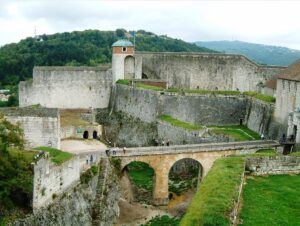
Vauban returned to work on the citadel’s fortifications and those of the city. This process lasted until 1711. The walls that surround the city were built during this time. Between the railway station and the centre of the city there is a complex moat system that’s now used by road traffic. Numerous forts, some of which date back to that time and which incorporate Vauban’s design elements, sit on the six hills that surround the city. The Citadel itself has two dry moats, with an outer and inner court. In the evenings, the illuminated Citadel stands above the city as a great landmark, and a testament to Vauban’s genius as a military engineer.
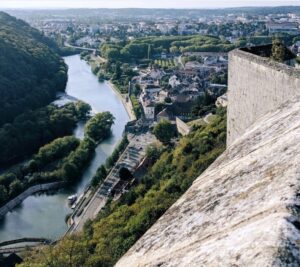
One of the best things to do in Besançon is to spend a few hours up on the Citadel, which covers 11 hectares, exploring the various buildings, now given over to culture and tourism, that over the centuries have served as barracks, a training ground for future officers, a state prison and a military penitentiary. The Citadel has a number of museums, including a folk museum, a museum of the Resistance and the Deportation, an insectarium and a small zoo. The ramparts offer stunning panoramic views of the town 100m below, and the surrounding countryside.
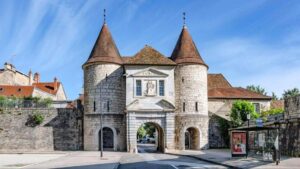
Exploring the town on foot is a delight. Most of the houses in the centre date back to the Middle Ages or the period of the Spanish Renaissance (15th – 16th centuries). The centre is mainly pedestrianised, with wonderful cathedrals and palaces.
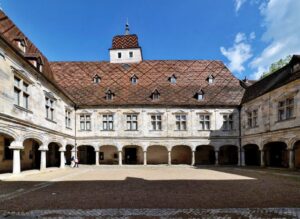
Visit the imposing 16th century Palais Granvelle, where a museum of the history and traditions of time—Musée du Temps—is located. The exhibits range from a sundial to an atomic clock and Foucault’s pendulum, which demonstrates that the earth turns, as well as tapestries recounting the life of Emperor Charles V. The palace tower affords a wonderful view over the city. You can enjoy lunch on the terrace of Brasserie Granvelle overlooking the gardens and bandstand.
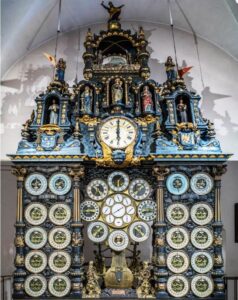
Another must-see is the Cathedrale Saint-Jean de Besançon, with its outstanding murals and renaissance paintings. At noon, the stunning astronomical clock in the cathedral’s tower chimes. It provides 122 indications, including years, seconds, time of the sunset and sunrise, and much more. There are 21 animated figures that perform various biblical scenes, depending on the time: for example, at noon, it’s the Resurrection of Christ.
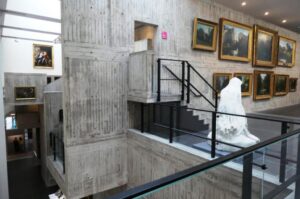
The very fine Musée de Beaux-Arts et de l’Archéologie claims to be the oldest public collection in France, founded in 1694. The building itself is most interesting. It’s a combination of a 19th century former grain market, and a raw concrete structure, filling the former inner courtyard, designed to present it as “a museum of unlimited growth”, a concept invented by Le Corbusier. Somehow, the two architectural styles work well together.
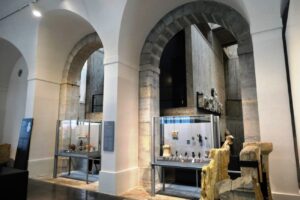
The collection covers over 6,000 graphic works by internationally-renowned artists, significant local, Mediterranean and Egyptian archaeological artefacts, ceramics, goldwork, a very impressive collection of paintings representing the main trends in the history of Western art from the end of the 15th up to the 20th centuries, and finally a number of contemporary works.
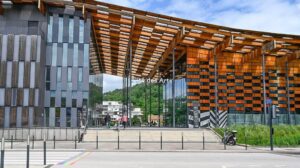
If contemporary artworks are more your style, the Fonds Regional d’Art Contemporain Franche-Comté (FRAC) is where to head. A modern timber work of art itself, the FRAC is found on Passage des Arts, bordering the River Doubs. The exhibitions at this contemporary art museum are constantly changing. Exhibitions may consist of video or digital art, written works, paintings, drawings and sculptures, along with other thought-provoking installations.
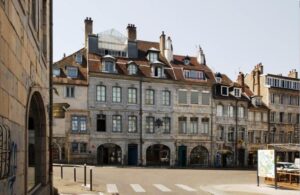
Besançon is the birthplace of some famous people, such as the writer Victor Hugo, the Lumière brothers (inventors of film projection), and Raymond Blanc, one of the most revered chefs in France as well as the UK, where he had a top restaurant for some years. Just down the road from Palais Granvelle you will come to the birthplace of Victor Hugo, located at 140 Grande Rue, where you can see a permanent exhibition dedicated to the great writer. Hugo’s father was an officer of Napoleon’s republic army, although his mother was a staunch supporter of the monarchy, which often led to a very tense atmosphere in the home. The museum is open every day except Tuesdays.
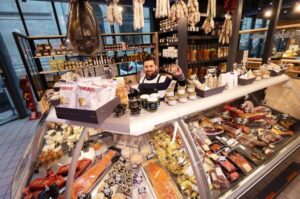
The city has a great market (Marché Couvert), the Beaux Arts covered market on rue Goudimel, at Place de la Revolution, which is open 6 days a week (closed on Mondays). It’s a wonderful place to discover all the local produce in one place. There are stalls selling fruit and vegetables, local meats and charcuterie, many cheeses, wines, chocolate, honey, confiture and much more. There are a couple of places to sit and enjoy a drink and a snack.
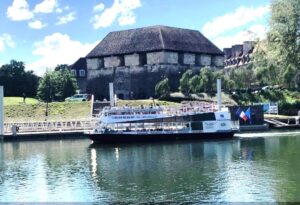
Besançon is a most pleasant, walkable city, and the Tourist Office can advise you on several urban walks. You can also take a boat ride on the river, which meanders around the heart of the city, with passages though two locks and a tunnel under the Citadel.
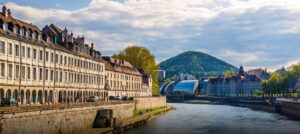
The Quai Vauban has a very long stretch of charming 18th century houses along the river, and is ideal for a promenade as well as being very close to the town centre.
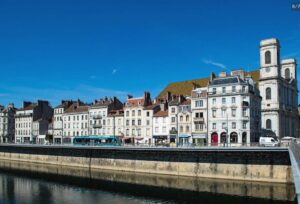
Start your walk at the Battant bridge, a bridge with five arches that has stood there since Roman times, when it was built along the road that connected Italy with the Province of the Rhine and with Vesontio. The middle arch has a span of 13 m. The Battant district is one of the oldest in the city, and retains its unique historic charm. It’s also one of the liveliest, full of small shops, nightlife and a market. Its original inhabitants consisted of grape growers, workers, and washerwomen. Today, the quartier is now under architectural heritage protection.
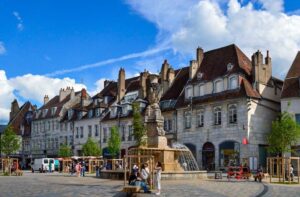
In the city, not far from the Battant bridge, you will come to the Grand Rue and Place de la Revolution, the largest square in the city, has shops and restaurants and the Besançon Musée de Beaux Arts, as mentioned above. In town, behind the cathedral, is the Porte Noire, a triumphal arch once called the Gate of Mars, and later, the Porta Nigra (Black Gate). The arch has a height ranging from 12 to 36 m. and was built as a monument commemorating the battles fought in Gaul by the Romans and their allies, the Sequani. Some scenes of the battles can be seen in the reliefs on the arch.
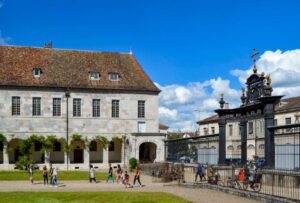
A very fine building, which is most often missed by visitors, is the 17th century St Jacques hospital, some 500m west of the city centre. The original colonnaded building stands round three sides of a large quadrangle, and is still part of the Besancon University Hospital. It contains one of the finest 18th century pharmacies in France, preserved as a museum.
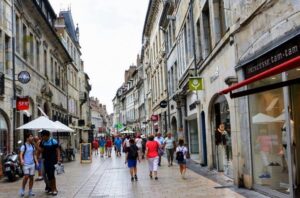
The central area of the old centre of Besançon is pedestrianised, making it very pleasant to stroll and explore all the delights of this small city, largely unknown to visitors. As well as its beautiful, historic quarter, the centre is also the starting point for a number of well-marked hiking trails up and down the valley, and to the hills around the city.
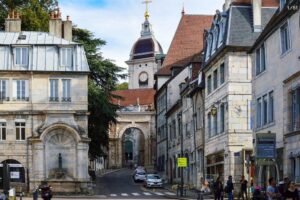
If you’re looking for a destination to explore that you may know little about, yet has a great deal to offer, Besançon could be the perfect answer. Getting there is easy, as it is connected to Paris by TGV train taking a little over 2 hours, and there are direct TGV links with Lille, Lyon, Marseille, Basel, Freiburg, Frankfurt and Luxemburg, among other destinations. By car, Besançon can be easily reached by motorway from Paris via Beaune or Dijon, from Calais, Germany via Mulhouse and from the south of France via Lyon. The nearest airport is probably Basel-Mulhouse.
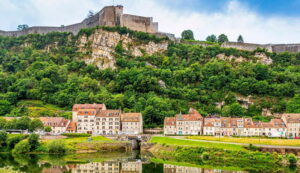


Bonjour Cheryl,
Besançon looks awesome.
In October, part of our river cruise is a day by road from Basil to Lyon. I hope we have some time in Besançon along the way.
à bientôt,
Bob
Hi Bob,
I do hope your trip takes in Besancon. We kept asking ourselves how we hadn’t managed to get back there and have a really good look at it–so glad we did. If your itinerary doesn’t get there, you’ll simply have to add it on to your growing list of places to get to “next time”! Actually, it’s easy to get to by train, if your upcoming trip doesn’t go there.
Cheers, Cheryl